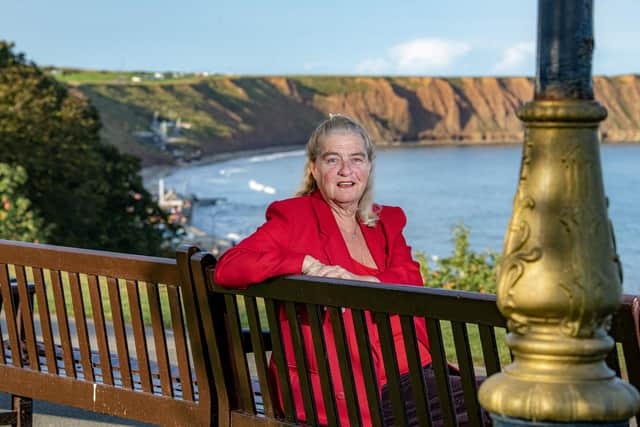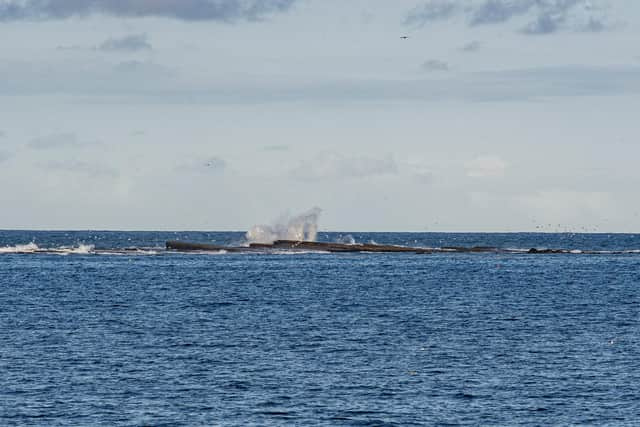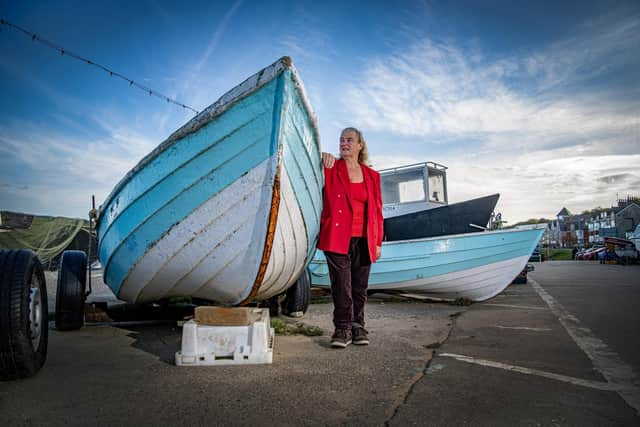Meet the self-taught historian who runs guided walks about shipwrecks and sea tragedies on the Yorkshire coast
The stories of some of the Yorkshire coast’s most notorious wrecks – and the human tragedies in their wake – are the subject of a guided walk by ‘housewife historian’ Catherine Welch as part of this month’s Filey Bay 1779 Festival, which commemorates a famous battle fought off the town during the American War of Independence.
Mrs Welch is an almost accidental guide, having gradually accrued years of knowledge of Filey’s history since retiring to the town in 2001 and starting to volunteer in its museum. She spotted the graves of shipwrecked sailors in the local churchyards, and her interest was piqued by memorials to several generations of men from the same families, some of whom had died in a single sinking.
Advertisement
Hide AdAdvertisement
Hide AdShe does not use the internet for her research, instead relying on old newspaper reports and other documents stored in Filey’s archives. Queries from members of the public often lead her down new paths.


"I’m very old school – I’m just a housewife with a knowledge of local history. Over the past 20 years, I’ve gradually collated my information into the guided walks. Some of the wreckage is still visible on the shore, and I’ve researched the casualties and the rescues. There was one wreck where nine members of the same family all died – three generations.”
The earliest wreck in Mrs Welch’s records is the Martin, sailing from Aberdeen to Dieppe when it ran aground during a major storm in 1542. Its cargo of wood and fish washed ashore, to be eargerly accepted by townspeople, who were also allowed to keep ‘coin’ from the ship despite a request from King James of Scotland for the money’s return.
The roster of doom stretches into the 1970s, when Mrs Welch herself remembers watching a wrecking at Filey Brigg. There are hundreds of vessels that sank in the vicinity of Filey, Speeton and Bempton, with around 20 profiled in her walks.
Advertisement
Hide AdAdvertisement
Hide AdThe Victorian age saw an expansion of maritime trade and many of the casualties are from the 19th century, when navigation still relied mainly on charts and a captain’s ability.


The Unico, an Italian barque carrying coal from Newcastle to Constantinople, was lost in 1871 but was the subject of grisly rumours that the drunken skipper had shot the mate before the grounding to prevent him telling the truth about the incident. Only one crewman survived, and a Genoan countess paid for a memorial stone for the sailors.
The Emulator’s fate was one of tragic irony. After serving as a minesweeper during World War One, she returned to Filey in 1919 and was converted into a fishing trawler – but was sunk by a mine just weeks later with the loss of all hands.
The tragedy of the Skegness in 1935 is only just passing from living memory. The trawler ran aground at Speeton, and lifeboat crews could only watch as 11 men died, unable to reach them for the rocks and the height of the waves.
Advertisement
Hide AdAdvertisement
Hide AdSome of the skeletal remains of ships can still be seen. At Speeton is the boiler from the Laura, an Austrian steam vessel which sank in fog in 1897 while carrying coal from Newcastle to Trieste. The 24 crew members were saved, but the coal washed ashore and the people of Filey enjoyed a winter of blazing fires.


The propeller of the Radium, an Italian cargo ship lost in 1923 on another coal run from Newcastle, is also visible. Lifeboats rescued all 28 hands.
With the introduction of modern navigation aids, the second half of the 20th century saw fewer and fewer vessels deviating from their course, and today it has been decades since a wrecking.
"Things have changed dramatically. These ships all have stories behind them, and they make us aware of what can happen at sea. We learn from them and grow. Filey has always been a fishing town, and people here would have seen the very earliest Roman and Viking ships. Wrecks have been part of their lives. The fishing families here have all lost someone – it only took one big storm.”
Advertisement
Hide AdAdvertisement
Hide AdThe Filey Bay 1779 Festival Shipwreck Walk takes place on Sunday September 24 at 11am. Meet at Royal Parade.
Yorkshire’s lost vessels
SS Rosa
This steam-powered Royal Navy fuel barge went down in 1930 and her boiler can be seen at West Scar, North Landing near Flamborough. The crew of 16 were rescued by the Flamborough lifeboat.
Radium
The Italian cargo ship was wrecked in 1923 after running aground at the base of Bempton Cliffs, near the RSPB sanctuary, in thick fog. The boilers and propellers can still be seen. She had been sailing from Newcastle to Venice carrying 5,000 tonnes of coal, and had struggled to stay on a safe course. The crew were rescued.
Sarb-J
A more recent casualty, the fishing trawler beached near Robin Hood's Bay in 1994 after its propeller became tangled in rope. The crew were airlifted off. The remains of the boat are still visible beneath the cliff.
Admiral von Tromp
Advertisement
Hide AdAdvertisement
Hide AdThe wreck of the Scarborough-based Tromp on Saltwick Bay is a true maritime mystery. She sank in 1976, but nobody knows why. She had been heading for the Barnacle Bank fishing grounds, and all seemed normal among the crew when she left port. The captain set the course before retiring and leaving John Addison at the wheel. He awoke to find that the vessel had foundered on the notorious Black Nab rocks, the worst reef on the coast. Addison appeared stunned, and the weather was fine. Experts later said it could not have changed course so drastically without human intervention.
The rescue was difficult, as heavy swell prevented the men from hanging onto the side of the boat, and they retreated to the wheelhouse to await assistance. After an hour, their heads reached the ceiling, and they had to swim through a window to escape the rising water. Addison had drowned already, and crewman George Eaves died when he was swept off the roof by a large wave.
The Whitby lifeboat attended the scene, but struggled to get close enough to safely reach the remaining crew. The vessels were even touching at one point, but rocket lines thrown to the men failed as they were still inside the wheelhouse. They were eventually rescued.
Creteblock
Perhaps the most pathetic casualty of the coast, the Creteblock sank when it was being towed on its way to be scrapped in 1947.
Advertisement
Hide AdAdvertisement
Hide AdThe former coal barge and harbour tug had lain derelict in Whitby since 1934, and it was decided to deliberately scuttle it out to sea. However, it hit shallow water at Whitby Scar, and ran aground at Saltwick Nab. As a hazard to other shipping, the wreckage was blown up, but some large pieces of concrete debris can still be spotted.
SS Rohilla
Although no visible wreckage survives above the surface, this 1914 grounding was one of the worst losses of life on the Whitby stretch of coast. The Rohilla was a requisitioned hospital ship on its way to evacuate wounded soldiers from France when it came to grief in a gale. The shore lighthouses were unlit during the war to deter enemy activity, and the captain believed they had hit a mine, although this was never confirmed. The death toll was 84, but all of the nurses and a Titanic survivor were rescued by RNLI lifeboats over a 50-hour period.
